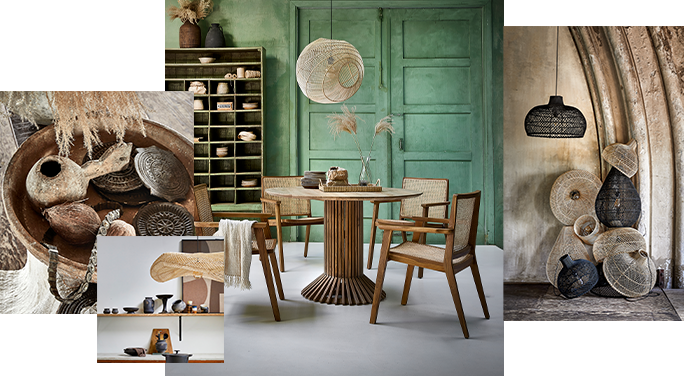In this section, we’d like to share some ‘tips & tricks’ for your own business. Our CEO has years of experience in sourcing items, hereby some of his tips & tricks. Read on for more!
Identifying quality furniture is quite an easy task when you know what to look for. Begin by closely inspecting the construction of your wooden furniture, examining both its exterior and interior. In this month’s ‘tips & tricks’ you can find out about all the key features to keep in mind during your assessment.

Wood species
Only selective hardwoods are suitable material candidates for quality furniture. Selective hardwoods stand out as prime candidates for crafting quality furniture. The weight of the wood is generally a great thing when it comes to furniture construction. Solid wood adds to the overall aesthetic appeal, but also ensures the furniture’s durability.
Furniture made from particleboard or other low-quality materials doesn’t withstand regular use and may show signs of wear and tear over time. Furniture made of fiberboard, particle board, pressboard laminates, or MDF lacks durability and longevity. Those materials are of lesser quality, they are cheap, and will perform as such – cutting the life of your furniture short.
Handmade
Handmade furniture is usually on the winning hand in comparison to quickly produced, machine-made furniture. The furniture passes through the hands of skilled people and carpenters. They know what they’re doing and take their time to do it correctly. With a deep understanding of their craft, these artisans take the necessary time to ensure precision and quality in every detail of their work.


Construction
The method of construction used in crafting furniture serves as a clear indicator of its quality. Paying attention to the joints is crucial, as they reveal much about the piece’s overall performance. The top two joints to look for that spell quality construction are ‘dovetail’ and ‘mortise & tenon’.
A dovetail joint is used to connect the front, side and back of a drawer or sides of chests. This type of joint is strong and secure, and will not come apart easily. Wood boards for the drawer are cut so that they interlock with one another, eventually they are glued together for added reinforcement.
Similarly, the age-old mortise and tenon joinery method contributes to the robustness of furniture. A tenon, precisely cut to fit into a mortise, forms a solid connection without often needing additional glue. Widely regarded as the strongest joint for quality wood furniture, mortise and tenon joinery stand the test of time.
While good joints may feature screws or dowels for reinforcement, poor-quality joints rely solely on nails, staples, or visible glue, compromising the sturdiness of the furniture.
Aesthetic appeal
The aesthetic appeal of furniture goes beyond its functional purpose; it is the visual expression that defines the character of a space. Good furniture possesses design elements that not only captivate the eye, but also harmonize with different styles, seamlessly integrating into various settings.

Red flags
Poor craftsmanship will make your furniture investment a short-lived disappointment. Not all “wood furniture” is created equal. Pieces made from real wood can always be sanded and refinished, as opposed to particle board, laminate, composite materials, MDF, or thin plywood.
Assets & liabilities
When buying a piece of furniture, please make sure it checks the following boxes:
Wood
Assets: must be a type of hardwood (e.g. oak, cherry, mahogany) or plywood: at least nine or more layers thick.
Liabilities: you don’t want any visible knots/cracks in the surface. Do not use; particleboard, pressboard, or thin plywood.
Frame
Assets: the even distribution of weight/wood; all pieces rest perfectly on the floor.
Liabilities: wobbling if pressure is applied to any corner; twisting/creaking if a side is lifted.
Drawers
Assets: floating bottoms, dust panels, metal guide rails; resting flush in closed position.
Liabilities: wood-on-wood sliding mechanism; no stops installed to limit travel distance.
Joints
Assets: dovetailed, mortise & tenon, dowelled, or screwed.
Liabilities: staples, nails, or signs that they have only been secured with glue.
Upholstery
Assets: aligned patterns in the fabric; any skirting should be weighted or at least have a lining.
Liabilities: sofa or chair arms/backs should have adequate padding (you cannot feel the frame).
Cushions
Assets: offer the option of reversibility; interior foam should be wrapped in padding.
Liabilities: no protective inner cover; loose fill that can shift and/or affect density rating.
Springs
Assets: hand-tied coil springs; set close together for strength and balanced resistance.
Liabilities: limit number several inches apart (affects comfort and long-term durability).
Antique furniture
There’s a reason that good wood furniture becomes antique and lasts for decades. Antique furniture is usually made very well, constructed of high-quality materials and most of the time they are very heavy. It also has history & character and is often one-of-a-kind. So obviously taking the antique route is never a bad idea.
Now you know what to take into consideration while buying your next piece of furniture!





